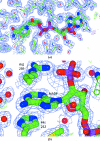Structure of aldose reductase from Giardia lamblia
- PMID: 21904059
- PMCID: PMC3169411
- DOI: 10.1107/S1744309111030879
Structure of aldose reductase from Giardia lamblia
Abstract
Giardia lamblia is an anaerobic aerotolerant eukaryotic parasite of the intestines. It is believed to have diverged early from eukarya during evolution and is thus lacking in many of the typical eukaryotic organelles and biochemical pathways. Most conspicuously, mitochondria and the associated machinery of oxidative phosphorylation are absent; instead, energy is derived from substrate-level phosphorylation. Here, the 1.75 Å resolution crystal structure of G. lamblia aldose reductase heterologously expressed in Escherichia coli is reported. As in other oxidoreductases, G. lamblia aldose reductase adopts a TIM-barrel conformation with the NADP(+)-binding site located within the eight β-strands of the interior.
Figures




Similar articles
-
Structure of porcine aldehyde reductase holoenzyme.Nat Struct Biol. 1995 Aug;2(8):687-92. doi: 10.1038/nsb0895-687. Nat Struct Biol. 1995. PMID: 7552731
-
X-ray structure and kinetic properties of ornithine transcarbamoylase from the human parasite Giardia lamblia.Proteins. 2009 Sep;76(4):1049-53. doi: 10.1002/prot.22469. Proteins. 2009. PMID: 19507245 Free PMC article. No abstract available.
-
The crystal structure of the aldose reductase.NADPH binary complex.J Biol Chem. 1992 Dec 5;267(34):24841-7. doi: 10.2210/pdb1abn/pdb. J Biol Chem. 1992. PMID: 1447221
-
Structural features of the aldose reductase and aldehyde reductase inhibitor-binding sites.Mol Vis. 1998 Sep 29;4:19. Mol Vis. 1998. PMID: 9756955 Review.
-
Ultra-high-resolution X-ray structure of proteins.Cell Mol Life Sci. 2004 Apr;61(7-8):774-82. doi: 10.1007/s00018-003-3405-0. Cell Mol Life Sci. 2004. PMID: 15095002 Free PMC article. Review.
Cited by
-
Aldose reductase from Schistosoma japonicum: crystallization and structure-based inhibitor screening for discovering antischistosomal lead compounds.Parasit Vectors. 2013 Jun 5;6:162. doi: 10.1186/1756-3305-6-162. Parasit Vectors. 2013. PMID: 23734964 Free PMC article.
-
In-depth proteomic and glycomic analysis of the adult-stage Cooperia oncophora excretome/secretome.J Proteome Res. 2013 Sep 6;12(9):3900-11. doi: 10.1021/pr400114y. Epub 2013 Aug 20. J Proteome Res. 2013. PMID: 23895670 Free PMC article.
-
Linearolactone Induces Necrotic-like Death in Giardia intestinalis Trophozoites: Prediction of a Likely Target.Pharmaceuticals (Basel). 2022 Jun 29;15(7):809. doi: 10.3390/ph15070809. Pharmaceuticals (Basel). 2022. PMID: 35890108 Free PMC article.
-
Ultrastructural and proapoptotic-like effects of kaempferol in Giardia duodenalis trophozoites and bioinformatics prediction of its potential protein target.Mem Inst Oswaldo Cruz. 2020 Oct 21;115:e200127. doi: 10.1590/0074-02760200127. eCollection 2020. Mem Inst Oswaldo Cruz. 2020. PMID: 33111756 Free PMC article.
References
-
- Alexandrov, A., Dutta, K. & Pascal, S. M. (2001). Biotechniques, 30, 1194–1198. - PubMed
-
- Alexandrov, A., Vignali, M., LaCount, D. J., Quartley, E., de Vries, C., De Rosa, D., Babulski, J., Mitchell, S. F., Schoenfeld, L. W., Fields, S., Hol, W. G., Dumont, M. E., Phizicky, E. M. & Grayhack, E. J. (2004). Mol. Cell. Proteomics, 3, 934–938. - PubMed
-
- Bohren, K. M., Brownlee, J. M., Milne, A. C., Gabbay, K. H. & Harrison, D. H. (2005). Biochim. Biophys. Acta, 1748, 201–212. - PubMed
-
- Borhani, D. W., Harter, T. M. & Petrash, J. M. (1992). J. Biol. Chem. 267, 24841–24847. - PubMed
Publication types
MeSH terms
Substances
Associated data
- Actions
Grants and funding
LinkOut - more resources
Full Text Sources
Research Materials

